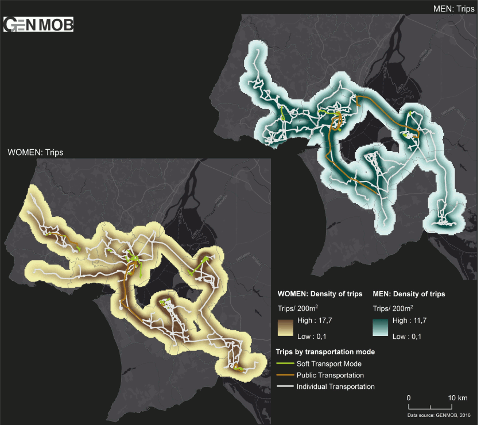La parità di genere e la città: un approccio metodologico per la mobilità nello spazio-tempo
Abstract
Telecomunicazioni e geotecnica (dispositivi elettronici, computer e software, comunicanti tra loro in tempo reale) al giorno d’oggi costituiscono la spina dorsale delle strutture urbane che supportano la vita quotidiana delle persone in tutto il mondo. Nonostante il riconoscimento del loro ruolo, poca attenzione è stata data agli impatti sociali e di genere di questi sistemi tecno-urbani, e poco è stato indagato su come possono essere utilizzati per promuovere politiche di mobilità più inclusive ed eque, con la partecipazione delle comunità.D’altra parte, la mobilità è una delle grandi sfide che le istituzioni devono affrontare, e la ricerca relativa allo squilibrio di genere nell’uso quotidiano dello spazio-tempo è modesta.
Approfondendo la conoscenza sulla mobilità e l’uso del tempo da parte delle donne e degli uomini in Portogallo, la ricerca che ha portato a questo articolo ha utilizzato la metodologia di monitoraggio in tempo reale di una giornata lavorativa al fine di esaminare i modelli di pendolarismo.
A tal fine, e basandosi su volontari, sono stati utilizzati per l’acquisizione dei dati smartphone e/o dispositivi con GPS integrato (trackers). I risultati dimostrano la fattibilità e la pertinenza della metodologia (telegeomonitoraggio degli spostamenti), evidenziano le disparità di genere nella mobilità e nell’uso del tempo, e contribuiscono ad incoraggiare l’adozione di politiche sociali più inclusive e degli strumenti di conciliazione.
Downloads
Riferimenti bibliografici
Aboím S. (2010), “Gender cultures and the division of labour in contemporary Europe”, The Sociological Review, 58(2), pp 171–196.
Acierno A. (2016), “Reading the New Urban Agenda in a gender perspective”, TRIA, 16(1/2016), pp 5-10.
Boccia T. (2016), “Habitat III: theories and practices of the women facing the global challenges in cities”, TRIA 16(1/2016), pp 17-20.
Capel H. (2016), “Pensar en ciudades habitables para el futuro”, Finisterra Revista Portuguesa de Geografia, LI(101), pp 25-43.
Denzin N. K. (1978), “Sociological Methods”, New York, McGraw-Hill.
EIGE (2013), “Reconciliation of Work and Family Life as a Condition of Equal Participation in the Labour Market”, Report, European Institute for Gender Equality. (http://eige.europa.eu).
EIGE (2015), “Supporting reconciliation of work, family and private life. Good Practices”, European Institute for Gender Equality, Luxembourg, Publications Office of the European Union. (http://eige.europa.eu).
Eurostat (2004), “How Europeans spend their time. Every day life of women and men. Data 1988-2002”, Eurostat Theme 3 Population and Social Conditions, Luxembourg, Office for Official Publications of the Europeans Communities.
Eurostat (2006), “Statistics in Focus. Population and social conditions, How is the time of women and men distributed in Europe?”, European Communities.
Eurostat (2009), “Harmonised European Time Use Surveys. 2008 Guidelines”. Collection: Methodologies and working papers Luxembourg, Office for Official Publications EU.
Fraser Taylor D. R.; Lauriault Tracey P. (eds.) (2014), “Developments in the Theory and Practice of the Cybercartography”. Applications and indigenous mapping, London, Elsevier.
Gaspar J., Queirós M., Marques da Costa N., Brito Henriques E. (2009), “Estudo de Diagnóstico e Criação de Indicadores de Género na Área do Território e Ambiente”, Lisboa: CEG, Universidade de Lisboa/FLUL & CIG http://www.igualdade.gov.pt/images/stories/documentos/documentacao/relatorios/relatorio_genero_territorio_ambiente.pdf).
Goodchild M. F. (2007), “Citizens as sensors: the world of volunteered geography”, Geojournal, 69, pp 211-221.
Goodchild M. F. (2008), “Commentary: whither VGI?”, GeoJournal, 72(3), pp 239-244.
Greed C. (2012), “Planning for sustainable transport or for people’s needs”, Urban Design and Planning, Volume 165, DP4, pp 219–229 (http://dx.doi.org/10.1680/udap.10.00033).
Greenfield A., Shepard M. (2007), “Urban Computing and Its Discontents”, Architecture and Situated Technologies Pamphlet 1, New York, The Architectural League of New York.
Hanlon S. (1996), “Where do women feature in public transport?” Women’s Travel Issues Second National Conference, Baltimore, October 1996.
Hasson Y., Polevoy M. (2011), “Gender Equality Initiatives in Transportation Policy, A review of the Literature”, Women’s Budget Forum, Heinrich Boell Stiftung, European Union, Hadassah Foundation.
Knafl K., Breitmayer B. J. (1989), “Triangulation in qualitative research: Issues of conceptual clarity and purpose”. In J. Morse (Ed.), Qualitative nursing research: A contemporary dialogue (pp. 193-203). Rockville, MD, Aspen.
Krefting L. (1991), “Rigor in qualitative research: The assessment of trustworthiness”, American Journal of Occupational Therapy, 45, pp 214-222.
Madariaga I. S. (2013), “Mobility of Care: introducing new concepts in urban transport”, In Sánchez de Madariaga, Inés, Roberts, Marion, Fair Shared Cities, The impact of gender planning in Europe, England and USA, Ashgate, pp 33-48.
Miller, H. J. (2005), “A Measurement Theory for Time Geography”, Geographical Analysis, 37, pp 17–45.
Neutens T.; Schwanen T.; Witlox F. (2011), “The Prism of Everyday Life: Towards a New Research Agenda for Time Geography”, Transport Reviews, 31(1), pp 25–47.
Queirós M., Marques da Costa N. (2012), “Knowledge on Gender Dimensions of Transportation in Portugal”, Dialogue and UniversalismE, 3(1), pp 47-69.
Shin D. H. (2009), “Ubiquitous city: Urban technologies, urban infrastructure and urban informatics”, Journal of Information Science, 35(5), pp 515-526.
Tavora I., Rubery J. (2013), “Female employment, labour market institutions and gender culture in Portugal”, European Journal of Industrial Relations, 19(3), pp 221–237.
Townsend A. M. (2013), “Smart Cities: Big Data, Civic Hackers, and the Quest for a New Utopia”, W.W. Norton & Company, Inc.

Copyright (c) 2017 Margarida Queirós Queirós

This work is licensed under a Creative Commons Attribution 4.0 International License.
Gli autori che pubblicano su questa rivista accettano le seguenti condizioni:- Gli autori mantengono i diritti sulla loro opera e cedono alla rivista il diritto di prima pubblicazione dell'opera, contemporaneamente licenziata sotto una Licenza Creative Commons - Attribuzione che permette ad altri di condividere l'opera indicando la paternità intellettuale e la prima pubblicazione su questa rivista.
- Gli autori possono aderire ad altri accordi di licenza non esclusiva per la distribuzione della versione dell'opera pubblicata (es. depositarla in un archivio istituzionale o pubblicarla in una monografia), a patto di indicare che la prima pubblicazione è avvenuta su questa rivista.
- Gli autori possono diffondere la loro opera online (es. in repository istituzionali o nel loro sito web) prima e durante il processo di submission, poiché può portare a scambi produttivi e aumentare le citazioni dell'opera pubblicata (Vedi The Effect of Open Access).
